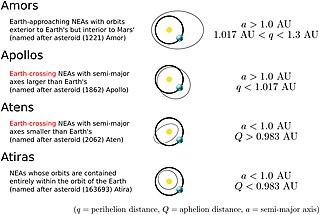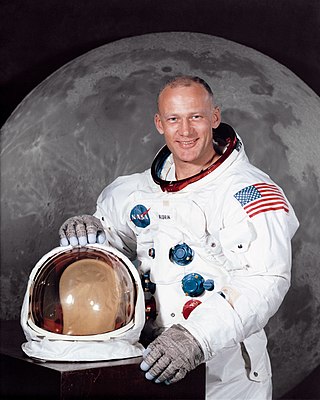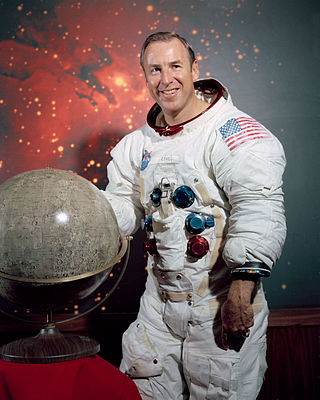Related Research Articles

Apollo is one of the Olympian deities in classical Greek and Roman religion and Greek and Roman mythology. Apollo has been recognized as a god of archery, music and dance, truth and prophecy, healing and diseases, the Sun and light, poetry, and more. One of the most important and complex of the Greek gods, he is the son of Zeus and Leto, and the twin brother of Artemis, goddess of the hunt. He is considered to be the most beautiful god and is represented as the ideal of the kouros. Apollo is known in Greek-influenced Etruscan mythology as Apulu.

Apollo 11 was a spaceflight conducted by the United States from July 16 to July 24, 1969. It marked the first time in history that humans landed on the Moon. Commander Neil Armstrong and Lunar Module Pilot Buzz Aldrin landed the Apollo Lunar Module Eagle on July 20, 1969, at 20:17 UTC, and Armstrong became the first person to step onto the Moon's surface six hours and 39 minutes later, on July 21 at 02:56 UTC. Aldrin joined him 19 minutes later, and they spent about two and a quarter hours together exploring the site they had named Tranquility Base upon landing. Armstrong and Aldrin collected 47.5 pounds (21.5 kg) of lunar material to bring back to Earth as pilot Michael Collins flew the Command Module Columbia in lunar orbit, and were on the Moon's surface for 21 hours, 36 minutes, before lifting off to rejoin Columbia.

Apollo 8 was the first crewed spacecraft to leave Earth's gravitational sphere of influence, and the first human spaceflight to reach the Moon. The crew orbited the Moon ten times without landing and then returned to Earth. The three astronauts—Frank Borman, James Lovell, and William Anders—were the first humans to see and photograph the far side of the Moon and an Earthrise.

The Apollo program, also known as Project Apollo, was the United States human spaceflight program carried out by the National Aeronautics and Space Administration (NASA), which succeeded in preparing and landing the first men on the Moon in 1969. It was first conceived in 1960 during President Dwight D. Eisenhower's administration as a three-person spacecraft to follow the one-person Project Mercury, which put the first Americans in space. Apollo was later dedicated to President John F. Kennedy's national goal for the 1960s of "landing a man on the Moon and returning him safely to the Earth" in an address to Congress on May 25, 1961. It was the third US human spaceflight program to fly, preceded by the two-person Project Gemini conceived in 1961 to extend spaceflight capability in support of Apollo.

Apollo 13 was the seventh crewed mission in the Apollo space program and the third meant to land on the Moon. The craft was launched from Kennedy Space Center on April 11, 1970, but the lunar landing was aborted after an oxygen tank in the service module (SM) ruptured two days into the mission, disabling its electrical and life-support system. The crew, supported by backup systems on the lunar module (LM), instead looped around the Moon in a circumlunar trajectory and returned safely to Earth on April 17. The mission was commanded by Jim Lovell, with Jack Swigert as command module (CM) pilot and Fred Haise as lunar module (LM) pilot. Swigert was a late replacement for Ken Mattingly, who was grounded after exposure to rubella.

Apollo 10 was the fourth human spaceflight in the United States' Apollo program and the second to orbit the Moon. NASA, the mission's operator, described it as a "dress rehearsal" for the first Moon landing. It was designated an "F" mission, intended to test all spacecraft components and procedures short of actual descent and landing.

Apollo 16 was the tenth crewed mission in the United States Apollo space program, administered by NASA, and the fifth and penultimate to land on the Moon. It was the second of Apollo's "J missions", with an extended stay on the lunar surface, a focus on science, and the use of the Lunar Roving Vehicle (LRV). The landing and exploration were in the Descartes Highlands, a site chosen because some scientists expected it to be an area formed by volcanic action, though this proved not to be the case.

Apollo 17 was the eleventh and final mission of NASA's Apollo program, the sixth and most recent time humans have set foot on the Moon or traveled beyond low Earth orbit. Commander Gene Cernan and Lunar Module Pilot Harrison Schmitt walked on the Moon, while Command Module Pilot Ronald Evans orbited above. Schmitt was the only professional geologist to land on the Moon; he was selected in place of Joe Engle, as NASA had been under pressure to send a scientist to the Moon. The mission's heavy emphasis on science meant the inclusion of a number of new experiments, including a biological experiment containing five mice that was carried in the command module.

The Apollo asteroids are a group of near-Earth asteroids named after 1862 Apollo, discovered by German astronomer Karl Reinmuth in the 1930s. They are Earth-crossing asteroids that have an orbital semi-major axis greater than that of the Earth but perihelion distances less than the Earth's aphelion distance.

Buzz Aldrin is an American former astronaut, engineer and fighter pilot. He made three spacewalks as pilot of the 1966 Gemini 12 mission, and was the Lunar Module Eagle pilot on the 1969 Apollo 11 mission. He was the second person to walk on the Moon after mission commander Neil Armstrong. Following the death of Michael Collins in 2021, he is the last surviving Apollo 11 crew member.

Moon landing conspiracy theories claim that some or all elements of the Apollo program and the associated Moon landings were hoaxes staged by NASA, possibly with the aid of other organizations. The most notable claim of these conspiracy theories is that the six crewed landings (1969–1972) were faked and that twelve Apollo astronauts did not actually land on the Moon. Various groups and individuals have made claims since the mid-1970s that NASA and others knowingly misled the public into believing the landings happened, by manufacturing, tampering with, or destroying evidence including photos, telemetry tapes, radio and TV transmissions, and Moon rock samples.

Apollo 13 is a 1995 American docudrama film directed by Ron Howard and starring Tom Hanks, Kevin Bacon, Bill Paxton, Gary Sinise, Ed Harris and Kathleen Quinlan. The screenplay by William Broyles Jr. and Al Reinert dramatizes the aborted 1970 Apollo 13 lunar mission and is an adaptation of the 1994 book Lost Moon: The Perilous Voyage of Apollo 13, by astronaut Jim Lovell and Jeffrey Kluger.

Eugene Andrew Cernan was an American astronaut, naval aviator, electrical engineer, aeronautical engineer, and fighter pilot. During the Apollo 17 mission, Cernan became the 11th human being to walk on the Moon. As he re-entered the Apollo Lunar Module after Harrison Schmitt on their third and final lunar excursion, he remains the most recent person to walk on the Moon.

James Arthur Lovell Jr. is an American retired astronaut, naval aviator, test pilot and mechanical engineer. In 1968, as command module pilot of Apollo 8, he became, with Frank Borman and William Anders, one of the first three astronauts to fly to and orbit the Moon. He then commanded the Apollo 13 lunar mission in 1970 which, after a critical failure en route, looped around the Moon and returned safely to Earth.

The Apollo Theater is a multi-use theater at 253 West 125th Street in the Harlem neighborhood of Upper Manhattan in New York City. It is a popular venue for black American performers and is the home of the TV show Showtime at the Apollo. The theater, which has approximately 1,500 seats across three levels, was designed by George Keister with elements of the neoclassical style. The facade and interior of the theater are New York City designated landmarks and are listed on the National Register of Historic Places. The nonprofit Apollo Theater Foundation (ATF) operates the theater, as well as two smaller auditoriums at the Victoria Theater and a recording studio at the Apollo.

The Hammersmith Apollo, currently called the Eventim Apollo for sponsorship reasons, and formerly known as the Hammersmith Odeon, is a live entertainment performance venue, originally built as a cinema called the Gaumont Palace. Located in Hammersmith, London, it is an art deco Grade II* listed building.

Live at the Apollo is the first live album by James Brown and the Famous Flames, recorded at the Apollo Theater in Harlem in October 1962 and released in May 1963 by King Records. Capturing Brown's popular stage show for the first time on record, the album was a major commercial and critical success and cemented his status as a leading R&B star.

Fe, Fi, Fo, Fum, and Phooey were five mice who traveled to the Moon and circled it 75 times on the 1972 Apollo 17 mission. NASA gave them identification numbers A3305, A3326, A3352, A3356, and A3400, and their nicknames were given by the Apollo 17 crew. The four male mice, one female mouse, and Evans orbited the Moon for a record-setting six days and four hours in the Apollo command module America as Cernan and Schmitt performed the Apollo program's last lunar excursions.
References
- ↑ "Apollo Records Story". bsnpubs. Retrieved 18 May 2016.